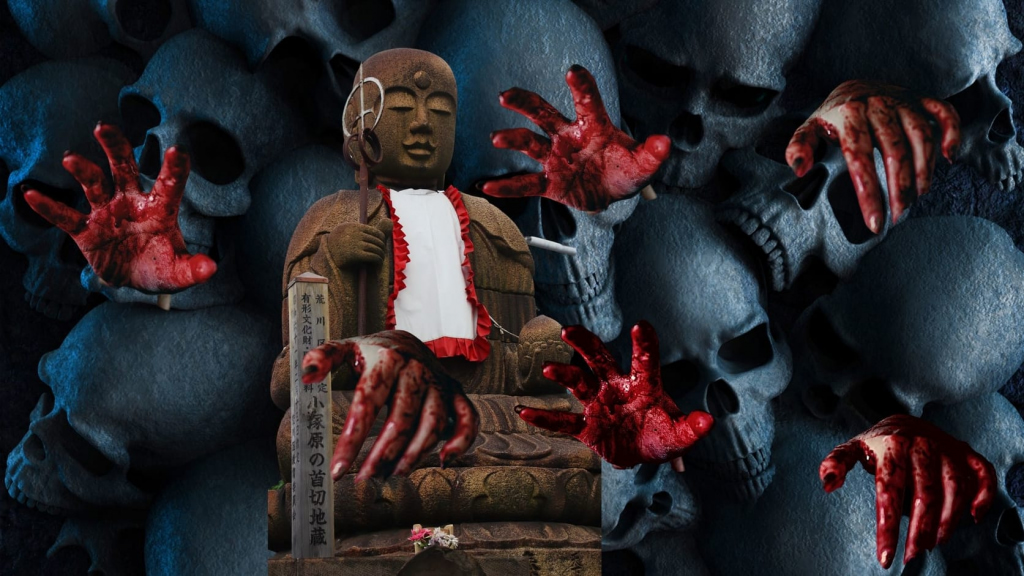The most infuriating part of any horror movie is always the movie characters making the dumbest choices possible, from opening and reading creepy books bound in human skin to checking out a weird noise coming from that old abandoned house’s basements — in complete darkness too. It’s like they want to be killed by angry murder-ghosts.
And that’s also the feeling you get when you read anything about Kozukappara.
A former execution site where torture prevailed
Kozukappara (小塚原刑場跡地) used to be one of Tokyo’s three main execution grounds (alongside Suzugamori and Denma-cho), back when the city was called Edo, and literally, every detail about it sounds like the setting of a separate horror film. Located around modern-day Minami Senju in Tokyo, Kozukappara was in use from 1651 to 1873, during which time up to 200,000 people were executed there. That’s an average of more than two deaths per day, every single day, for 222 years, and special attention has been paid to ensuring that each of those people left this earthly plane swearing vengeance upon the world.
Before execution, it wasn’t uncommon for a condemned man to be locked inside a box with just his head sticking out. The box would then be rolled out to a popular part of Edo so that the locals could abuse it for up to two days. The criminal would then be crucified naked at Kozukappara and have his corpse left on display for three days. Other means of execution at Kozukappara included boiling and burning people alive, but the most popular way has always been beheading.
“That’s an average of more than two deaths per day, every single day, for 222 years”
After a condemned man had his head cut off, it would then be cleaned and exhibited along a street near the execution grounds. And as if that wasn’t enough to drive down the real estate prices in the area, the same road was also said to be littered with human bones and bits of human flesh. As a final insult to the executed, their bodies were not cremated in accordance with Japanese customs. Some were used for anatomy studies by medical students, while others were buried in shallow graves near the displayed heads. The graves were so shallow that stray dogs would regularly dig them up and scatter human remains all along what came to be known as the Street of Bones.
The Bridge of Tears
Not satisfied with being adjacent to just one area with a horror title-esque name, the actual killing field of Kozukappara was only accessible through (wait for it!) the Bridge of Tears (Namidabashi.) The long-gone bridge used to cross the Omoigawa river, which is currently underground, but the name “Namidabashi” has stuck around in the form of a hotel and bus stops.
Systemic Prejudice
If you’re thinking right now, “Well, how could this place get any worse?” then clearly you haven’t been paying attention to what I said about movie tropes. You NEVER ask that question.
Anyway, because of all the deaths, Kozukappara was off-limits to regular people because it was considered desecrated. Buddhism has a whole thing about blood and death being taboo, yet someone still had to work at the execution grounds. So all those jobs went to the Eta people, Japan’s own caste of untouchables who, despite doing necessary work that no one else wanted to touch, weren’t society’s favorite people. The lucky ones were merely second-class citizens, while most were probably third-, and fourth-class. The name “Eta” literally means “lots of dishonor/sin.” The prejudice against Eta people continued well into the 21st century, with these descendants of butchers and undertakers finding themselves discriminated against wherever they went. Things have gotten much better since then but the problem continues to persist. The area around Kozukappara used to be proof of that.
Abandoned and Covered-up
The execution grounds were closed during the Meiji era to convince the West that Japan was a modern country, but because of its connection to the Eta people, the entire area around Kozukappara was pretty much abandoned. Until about ten years ago or so, it was still one of Japan’s rare ghettos/skid rows, like Yokohama’s Kotobukicho or Osaka’s Nishinari, populated mostly by the working poor, day laborers, and the homeless. Before 2010, it wasn’t that uncommon to find some of the homeless or local drunks sleeping in the middle of the road there. The area has since undergone gentrification, trying to shed its gruesome past. It’s not too difficult, seeing how little of Kozukappara survived.
Today, despite all that remains of the actual execution grounds is a small cemetery and the original bodhisattva statue in front of which the condemned were beheaded (it’s lovingly known as the Beheading Jizo), Kozukappara is known as one of the most haunted places in the capital. All sorts of reports of mysterious occurrences, odd sounds and unexplainable phenomena can be easily found online when researching the area.
Railroad tracks now cover the original killing site, so if you ever rode the Joban or Hibiya lines and felt an unexplainable chill or saw the lights flickering around Minami Senju, now you know why.
Updated On February 20, 2021








